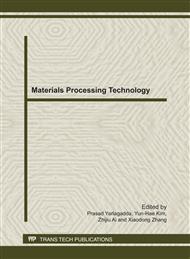p.608
p.612
p.616
p.621
p.627
p.633
p.639
p.645
p.650
Cause Analysis of Buttress Premium Thread Connection Pullout for a Well
Abstract:
The buttress thread connection was used in deep well or ultra-deep well widely because of its high joint efficiency. Pullout failure scarcely happen on buttress premium thread connection with great joint strength and good sealing property. Direct evidences about connection dropout couldn’t get in most cases by reason of casing string had fallen into well or casing string had been concreted in formation by cement. Now the difficulty of analysis on pullout is higher and higher. A buttress premium thread casing joint had pulled out at mill end of coupling in a straight well and dropout casing string couldn’t get out of the well. Research on this pullout case was carried out combining relative theories with tests. Macroscopic analysis and dimension measurement were done for dropout coupling. The material’s physical and chemical properties were checked. Thread inspection and full-scale tests were done for two casing simples that are same lot with pullout. Metallograph analysis was carried out on load flank and guide flank in box thread of pullout coupling and same lot new coupling. The results showed that dropout failure was ascribe to inadequate make-up torque at mill end of pullout coupling and complex downhole condition and improper handling in the oil field. On the other hand joint’s strength decline on the effect of unsuitable heat treatment to coupling and greatly uneven black crested pin thread around circumference. The pertinence measures were laid down at the end of this passage.
Info:
Periodical:
Pages:
627-632
Citation:
Online since:
September 2011
Authors:
Keywords:
Price:
Сopyright:
© 2011 Trans Tech Publications Ltd. All Rights Reserved
Share:
Citation:


